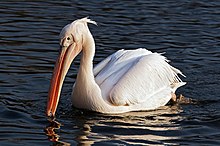Great white pelican
| Great white pelican | |
|---|---|
 |
|
| Scientific classification | |
| Kingdom: | Animalia |
| Phylum: | Chordata |
| Class: | Aves |
| Order: | Pelecaniformes |
| Family: | Pelecanidae |
| Genus: | Pelecanus |
| Species: | P. onocrotalus |
| Binomial name | |
|
Pelecanus onocrotalus Linnaeus, 1758 |
|
The great white pelican (Pelecanus onocrotalus) also known as the eastern white pelican, rosy pelican or white pelican is a bird in the pelican family. It breeds from southeastern Europe through Asia and in Africa in swamps and shallow lakes.
The great white pelican is a huge bird, with only the Dalmatian pelican averaging larger amongst the pelicans. The wingspan can range from 226 to 360 cm (7.41 to 11.81 ft), with the latter measurement the largest recorded among extant flying animals outside of the great albatrosses. The total length of the great white pelican can range from 140 to 180 cm (55 to 71 in), with the enormous bill comprising 28.9 to 47.1 cm (11.4 to 18.5 in) of that length. Adult males, weigh from 9 to 15 kg (20 to 33 lb), though large races from the Palaearctic are usually around 11 kg (24 lb) with few exceeding 13 kg (29 lb). Females are considerably less bulky and heavy, weighing from 5.4 to 9 kg (12 to 20 lb). Among standard measurements, the wing chord length is 60 to 73 cm (24 to 29 in), the tail is 16 to 21 cm (6.3 to 8.3 in) and the tarsus is 13 to 14.9 cm (5.1 to 5.9 in). The standard measurements from differing areas indicate that pelicans of the species from the Western Palaearctic are somewhat larger in size than ones that reside in Asia and in Africa.
Immature great white pelicans are grey and have dark flight feathers. In flight, it is an elegant soaring bird, with the head held close to and aligned with the body by a downward bend in the neck. In breeding condition the male has pinkish skin on its face and the female has orangey skin. It differs from the Dalmatian pelican by its pure white, rather than greyish-white, plumage, a bare pink facial patch around the eye and pinkish legs. Males are larger than females, and have a long beak that grows in a downwards arc, as opposed to the shorter, straighter beak of the female. The spot-billed pelican of Asia is slightly smaller than the great white, with clear brownish-grey plumage and a paler, duller-colored bill. Similarly, the pink-backed pelican is smaller with brownish-grey plumage, with a light pink to off-grey bill and a pinkish wash to the back.
...
Wikipedia

